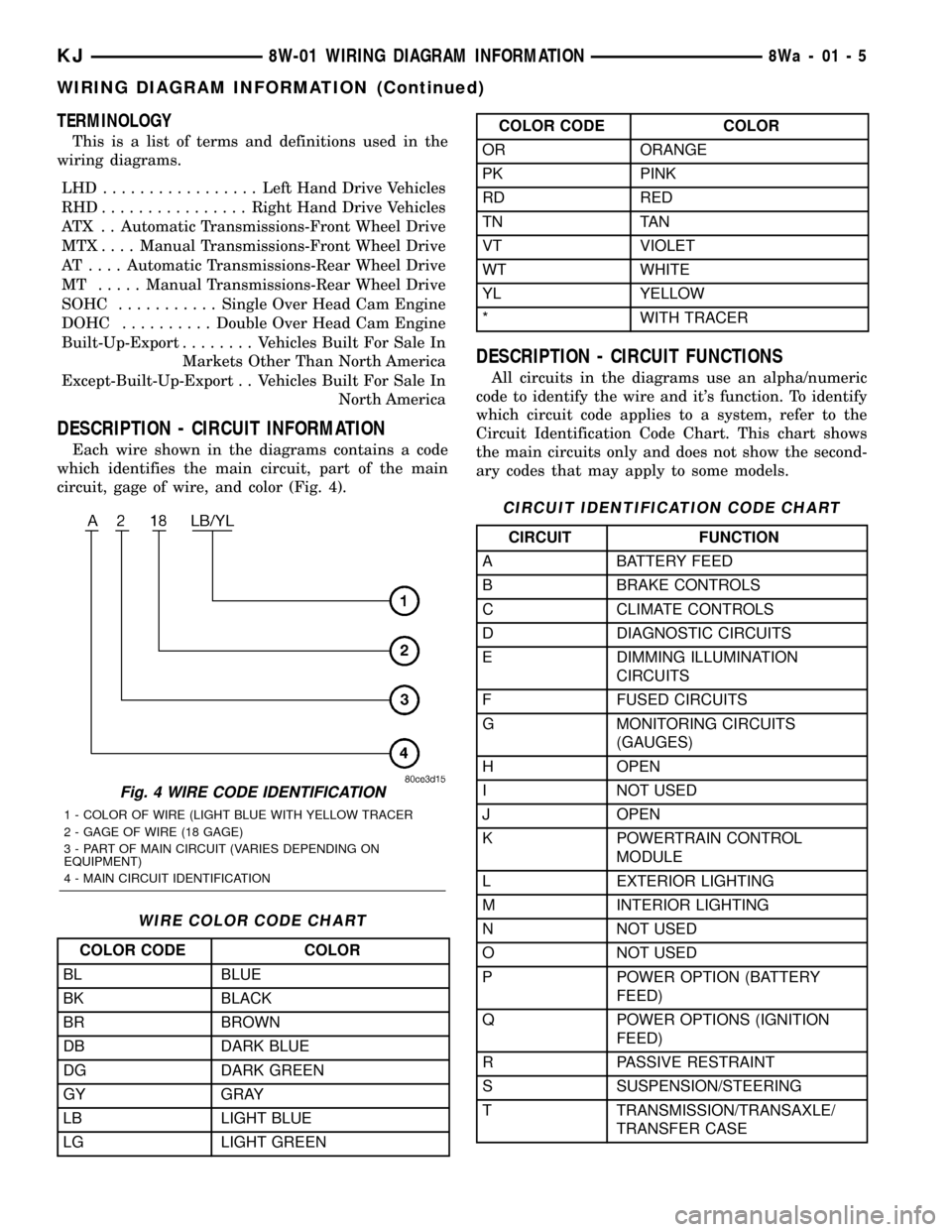Fuse JEEP LIBERTY 2002 KJ / 1.G Workshop Manual
[x] Cancel search | Manufacturer: JEEP, Model Year: 2002, Model line: LIBERTY, Model: JEEP LIBERTY 2002 KJ / 1.GPages: 1803, PDF Size: 62.3 MB
Page 731 of 1803

control stalk to a detent position selects the Off,
Delay, or On rear wiper system operating modes.
Rotating the control ring on the control stalk to
either of two Wash positions actuates the momentary
rear washer system switch. The multi-function
switch provides hard wired outputs to the rear wiper
module and the washer pump/motor unit for all rear
wiper and washer system functions.
The rear wiper and washer system will only oper-
ate when the ignition switch is in the Accessory or
On positions, and the rear flip-up glass and tailgate
ajar switches are closed. Battery current is directed
from a fuse in the Junction Block (JB) to the multi-
function switch through a fused ignition switch out-
put (run-acc) circuit. The internal circuitry of the
right (wiper) control stalk of the multi-function
switch then provides battery current signals through
a rear wiper on driver circuit and a rear wiper inter-
mittent driver circuit to the rear wiper module and
to the Body Control Module (BCM). The BCM uses
these rear wiper system inputs as a signal to lock the
rear flip-up glass and the tailgate to prevent the rear
flip-up glass or tailgate from being opened for as long
as the rear wiper is operating. The multi-function
switch circuitry also uses this battery current and a
ground circuit input to directly control the operation
and direction of the reversible electric washer pump/
motor unit.
A separate fuse in the JB provides battery current
to the electronic control circuitry of the rear wiper
module through a fused B(+) circuit. The rear wiper
module uses this fused B(+) input to park the rear
wiper blade off of the rear flip-up glass if the ignition
switch is turned to the Off position while the rear
wiper is operating, or if the ignition switch is turned
to the Off position before the rear wiper blade has
parked. However, if the ignition switch is turned to
the Off position while the rear wiper is operating,
then turned back On, the rear wiper switch must be
cycled to the Off position and back to the On or
Delay position before the rear wiper will operate
again. In addition, the rear wiper module receives an
input from the rear flip-up glass ajar switch on a
flip-up glass ajar switch sense circuit, which prevents
the rear wiper from operating when the flip-up glass
is not closed or fully latched.
The hard wired circuits and components of the rear
wiper and washer system may be diagnosed and
tested using conventional diagnostic tools and proce-
dures. Following are paragraphs that briefly describe
the operation of each of the rear wiper and washer
system operating modes.
CONTINUOUS WIPE MODE When the On posi-
tion of the control ring on the right (wiper) control
stalk of the multi-function switch is selected, the
multi-function switch circuitry directs a battery cur-rent signal to the rear wiper module through the
rear wiper on driver circuit, causing the rear wiper to
cycle continuously at a fixed speed.
INTERMITTENT WIPE MODE When the Delay
position of the control ring on the right (wiper) con-
trol stalk of the multi-function switch is selected, the
multi-function switch circuitry directs a battery cur-
rent signal to the rear wiper module through the
rear wiper intermittent driver circuit, causing the
rear wiper to cycle intermittently at a fixed delay
interval.
WASH MODE When the momentary Wash (after
On) position of the control ring on the right (wiper)
control stalk of the multi-function switch is selected,
the multi-function switch circuitry directs both bat-
tery current and ground to the washer pump/motor
unit, and a battery current signal to be provided to
the rear wiper module through the rear wiper on
driver circuit. This will cause the washer pump/mo-
tor unit to be energized and the rear wiper to cycle
continuously at a fixed speed for as long as the rear
Wash switch is held closed.
WIPE-AFTER-WASH MODE When the momentary
Wash (before Off) position of the control ring on the
right (wiper) control stalk of the multi-function
switch is selected, the multi-function switch circuitry
directs both battery current and ground to the
washer pump/motor unit, and a battery current sig-
nal to be provided to the rear wiper module through
the rear wiper on driver circuit. This will cause the
washer pump/motor unit to be energized and the rear
wiper to cycle continuously at a fixed speed for as
long as the rear Wash switch is held closed. When
the control ring is released to the Off position, the
washer pump/motor is de-energized, but the circuitry
within the rear wiper module will provide several
additional wipe cycles to complete the wipe-after-
wash mode cycle.
DIAGNOSIS AND TESTING - REAR WIPER &
WASHER SYSTEM
REAR WIPER SYSTEM
The diagnosis found here addresses an electrically
inoperative rear wiper system. If the rear wiper
motor operates, but the wiper does not move on the
rear flip-up glass, inspect the mechanical connection
between the rear wiper arm and the rear wiper
motor output shaft. If OK, replace the faulty rear
wiper module. If the wiper operates, but chatters,
lifts, or does not clear the glass, clean and inspect
the rear wiper system components as required. (Refer
to 8 - ELECTRICAL/REAR WIPERS/WASHERS -
INSPECTION) and (Refer to 8 - ELECTRICAL/
REAR WIPERS/WASHERS - CLEANING). Refer to
the appropriate wiring information. The wiring infor-
8R - 30 REAR WIPERS/WASHERSKJ
REAR WIPERS/WASHERS (Continued)
Page 732 of 1803

mation includes wiring diagrams, proper wire and
connector repair procedures, details of wire harness
routing and retention, connector pin-out information
and location views for the various wire harness con-
nectors, splices and grounds.
WARNING: ON VEHICLES EQUIPPED WITH AIR-
BAGS, DISABLE THE SUPPLEMENTAL RESTRAINT
SYSTEM BEFORE ATTEMPTING ANY STEERING
WHEEL, STEERING COLUMN, DRIVER AIRBAG,
PASSENGER AIRBAG, SEAT BELT TENSIONER,
SIDE CURTAIN AIRBAG, OR INSTRUMENT PANEL
COMPONENT DIAGNOSIS OR SERVICE. DISCON-
NECT AND ISOLATE THE BATTERY NEGATIVE
(GROUND) CABLE, THEN WAIT TWO MINUTES FOR
THE SYSTEM CAPACITOR TO DISCHARGE BEFORE
PERFORMING FURTHER DIAGNOSIS OR SERVICE.
THIS IS THE ONLY SURE WAY TO DISABLE THE
SUPPLEMENTAL RESTRAINT SYSTEM. FAILURE TO
TAKE THE PROPER PRECAUTIONS COULD
RESULT IN ACCIDENTAL AIRBAG DEPLOYMENT
AND POSSIBLE PERSONAL INJURY.
(1) Check that the interior lighting switch on the
left (lighting) control stalk of the multi-function
switch is not in the dome lamp disable position. With
all four doors and the tailgate closed, open the rear
flip-up glass. The interior lamps should light. Close
the rear flip-up glass. Note whether the interior
lamps remain lighted. They should turn off after
about thirty seconds. If OK, go to Step 2. If not OK,
go to Step 9.
(2) Check the fused B(+) fuse (Fuse 17 - 15
ampere) in the Junction Block (JB). If OK, go to Step
3. If not OK, repair the shorted circuit or component
as required and replace the faulty fuse.
(3) Check for battery voltage at the fused B(+) fuse
(Fuse 17 - 15 ampere) in the JB. If OK, go to Step 4.
If not OK, repair the open fused B(+) circuit between
the JB and the Power Distribution Center (PDC) as
required.
(4) Check the fused ignition switch output (run-
acc) fuse (Fuse 22 - 10 ampere) in the JB. If OK, go
to Step 5. If not OK, repair the shorted circuit or
component as required and replace the faulty fuse.
(5) Turn the ignition switch to the On position.
Check for battery voltage at the fused ignition switch
output (run-acc) fuse (Fuse 22 - 10 ampere) in the
JB. If OK, turn the ignition switch to the Off position
and go to Step 6. If not OK, repair the open fused
ignition switch output (run-acc) circuit between the
JB and the ignition switch as required.
(6) Disconnect and isolate the battery negative
cable. Disconnect the instrument panel wire harness
connector for the multi-function switch (Connector
C-2) from the switch connector receptacle. Reconnect
the battery negative cable. Turn the ignition switchto the On position. Check for battery voltage at the
fused ignition switch output (run-acc) circuit cavity of
the instrument panel wire harness connector for the
multi-function switch (Connector C-2). If OK, go to
Step 7. If not OK, repair the open fused ignition
switch output (run-acc) circuit between the multi-
function switch and the JB as required.
(7) Turn the ignition switch to the Off position.
Disconnect and isolate the battery negative cable.
Test the multi-function switch. (Refer to 8 - ELEC-
TRICAL/LAMPS/LIGHTING - EXTERIOR/MULTI-
FUNCTION SWITCH - DIAGNOSIS AND
TESTING). If the multi-function switch tests OK,
reconnect the instrument panel wire harness connec-
tors for the multi-function switch to the switch con-
nector receptacles and go to Step 8. If the multi-
function switch does not test OK, replace the faulty
switch.
(8) Remove the tailgate inner trim panel. Discon-
nect the tailgate wire harness connector for the rear
wiper module from the module connector receptacle.
Check for continuity between the ground circuit cav-
ity of the tailgate wire harness connector for the rear
wiper module and a good ground. There should be
continuity. If OK, go to Step 9. If not OK, repair the
open ground circuit to ground (G312) as required.
(9) Check for continuity between the flip-up glass
ajar switch sense circuit cavity of the tailgate wire
harness connector for the rear wiper module and a
good ground. There should be continuity with the
rear flip-up glass open, and no continuity with the
rear flip-up glass closed. If OK, go to Step 10. If not
OK, repair the open flip-up glass ajar circuit between
the rear wiper module and the flip-up glass ajar
switch as required.
(10) Reconnect the battery negative cable. Check
for battery voltage at the fused B(+) circuit cavity of
the tailgate wire harness connector for the rear wiper
module. If OK, go to Step 11. If not OK, repair the
open fused B(+) circuit between the rear wiper mod-
ule and the JB as required.
(11) Turn the ignition switch to the On position.
Turn the control ring on the right (wiper) control
stalk of the multi-function switch to the Delay posi-
tion. Check for battery voltage at the rear wiper
intermittent driver circuit cavity of the tailgate wire
harness connector for the rear wiper module. If OK,
go to Step 12. If not OK, repair the open rear wiper
intermittent driver circuit between the rear wiper
module and the multi-function switch as required.
(12) Turn the control ring on the right (wiper) con-
trol stalk of the multi-function switch to the On posi-
tion. Check for battery voltage at the rear wiper on
driver circuit cavity of the tailgate wire harness con-
nector for the rear wiper module. If OK, replace the
faulty rear wiper module. If not OK, repair the open
KJREAR WIPERS/WASHERS 8R - 31
REAR WIPERS/WASHERS (Continued)
Page 742 of 1803

(3) Raise the pivot block latch release tab until it
is perpendicular to the rear wiper blade superstruc-
ture (Fig. 14).
(4) Insert the hook formation on the tip of the
wiper arm through the window in the wiper blade
pivot block/latch unit.
(5) Slide the wiper blade pivot block/latch up into
the hook formation on the tip of the wiper arm until
the hook is firmly seated against the pivot block.
(6) Press the pivot block latch release tab down-
ward until it snaps into its locked position over the
top of the wiper arm.
(7) Gently lower the wiper arm and place the arm
support in the tailgate park ramp.
REAR WIPER MOTOR
DESCRIPTION
The rear wiper motor is concealed within the tail-
gate, below the rear flip-up glass opening and behind
the tailgate inner trim panel. The end of the motor
output shaft that protrudes through the tailgate
outer panel to drive the rear wiper arm and blade is
the only visible component of the rear wiper motor
(Fig. 15). A rubber gasket, a bezel, and a nut secure
and seal the motor output shaft to the tailgate outer
panel. A molded plastic nut cover snaps onto the
bezel to conceal the nut and improve appearance. An
integral connector receptacle connects the rear wipermotor to the vehicle electrical system through a ded-
icated take out and connector of the tailgate wire
harness. The rear wiper motor consists of the follow-
ing major components:
²Bracket- The rear wiper motor bracket consists
of a stamped steel mounting plate for the wiper
motor that is secured with screws through two rub-
ber insulators to the tailgate inner panel.
²Rear Wiper Module- The rear wiper motor
electronic controls are concealed beneath a molded
plastic cover and includes the rear wiper system elec-
tronic logic and rear wiper motor electronic controls.
²Motor- The permanent magnet rear wiper
motor is secured with screws to the rear wiper motor
bracket. The wiper motor includes an integral trans-
mission, and the motor output shaft.
The rear wiper motor cannot be adjusted or
repaired. If any component of the motor is faulty or
damaged, the entire rear wiper motor unit must be
replaced. The motor output shaft gasket, bezel, nut,
and nut cover are available for service replacement.
OPERATION
The rear wiper motor receives non-switched bat-
tery current through a fuse in the Junction Block
(JB) on a fused B(+) circuit and is connected to
ground at all times. The rear wiper motor operation
is controlled by the vehicle operator through battery
current signal inputs received by the rear wiper
motor electronic control module from the rear wiper
switch circuitry that is integral to the right (wiper)
control stalk of the multi-function switch on the
steering column. The module also receives an exter-
nal control input from the flip-up glass ajar switch
sense circuit. If the rear wiper module senses that
the flip-up glass is ajar, it will not allow the rear
wiper motor to operate.
The rear wiper module electronic control logic uses
these inputs, its internal inputs, and its program-
ming to provide a continuous wipe mode, an inter-
mittent wipe mode, a wipe-after-wash mode, and off-
the-glass wiper blade parking. The wiper blade
cycling is controlled by the internal electronic con-
trols of the module. The module controls current flow
to the wiper motor brushes and provides an elec-
tronic speed control that speeds the wiper blade near
the center of the glass, but slows the wiper blade
during directional reversals at each end of the wipe
pattern and during wiper blade off-the-glass parking
for quieter operation. The wiper motor transmission
converts the rotary output of the wiper motor to the
back and forth wiping motion of the rear wiper arm
and blade on the rear flip-up glass.
Fig. 15 Rear Wiper Motor
1 - SCREW (2)
2 - INSULATOR (2)
3 - BRACKET
4 - OUTPUT SHAFT
5 - SEAL
6 - CONNECTOR RECEPTACLE
7 - COVER
8 - MOTOR
KJREAR WIPERS/WASHERS 8R - 41
REAR WIPER BLADE (Continued)
Page 748 of 1803

8W-01 WIRING DIAGRAM INFORMATION
TABLE OF CONTENTS
page page
WIRING DIAGRAM INFORMATION
DESCRIPTION
DESCRIPTION - HOW TO USE WIRING
DIAGRAMS...........................1
DESCRIPTION - CIRCUIT INFORMATION....5
DESCRIPTION - CIRCUIT FUNCTIONS......5
DESCRIPTION - SECTION IDENTIFICATION
AND INFORMATION....................6
DESCRIPTION - CONNECTOR, GROUND
AND SPLICE INFORMATION..............6
WARNINGS - GENERAL...................6
DIAGNOSIS AND TESTING - WIRING
HARNESS............................7
STANDARD PROCEDURE
STANDARD PROCEDURE -
ELECTROSTATIC DISCHARGE (ESD)
SENSITIVE DEVICES...................8
STANDARD PROCEDURE - TESTING OF
VOLTAGE POTENTIAL...................8
STANDARD PROCEDURE - TESTING FOR
CONTINUITY..........................8STANDARD PROCEDURE - TESTING FOR A
SHORT TO GROUND...................9
STANDARD PROCEDURE - TESTING FOR A
SHORT TO GROUND ON FUSES
POWERING SEVERAL LOADS............9
STANDARD PROCEDURE - TESTING FOR A
VOLTAGE DROP.......................9
SPECIAL TOOLS
WIRING/TERMINAL....................10
CONNECTOR
REMOVAL.............................10
INSTALLATION.........................13
DIODE
REMOVAL.............................13
INSTALLATION.........................13
TERMINAL
REMOVAL.............................13
INSTALLATION.........................13
WIRE
STANDARD PROCEDURE - WIRE SPLICING . . 13
WIRING DIAGRAM
INFORMATION
DESCRIPTION
DESCRIPTION - HOW TO USE WIRING
DIAGRAMS
DaimlerChrysler Corporation wiring diagrams are
designed to provide information regarding the vehi-
cles wiring content. In order to effectively use the
wiring diagrams to diagnose and repair
DaimlerChrysler Corporation vehicles, it is important
to understand all of their features and characteris-
tics.
Diagrams are arranged such that the power (B+)
side of the circuit is placed near the top of the page,
and the ground (B-) side of the circuit is placed near
the bottom of the page (Fig. 1).
All switches, components, and modules are shown
in the at rest position with the doors closed and the
key removed from the ignition (Fig. 2).Components are shown two ways. A solid line
around a component indicates that the component is
complete. A dashed line around the component indi-
cates that the component is being shown is not com-
plete. Incomplete components have a reference
number to indicate the page where the component is
shown complete.
It is important to realize that no attempt is made
on the diagrams to represent components and wiring
as they appear on the vehicle. For example, a short
piece of wire is treated the same as a long one. In
addition, switches and other components are shown
as simply as possible, with regard to function only.
SYMBOLS
International symbols are used throughout the wir-
ing diagrams. These symbols are consistent with
those being used around the world (Fig. 3).
KJ8W-01 WIRING DIAGRAM INFORMATION8Wa-01-1
Page 752 of 1803

TERMINOLOGY
This is a list of terms and definitions used in the
wiring diagrams.
LHD .................Left Hand Drive Vehicles
RHD................Right Hand Drive Vehicles
ATX . . Automatic Transmissions-Front Wheel Drive
MTX....Manual Transmissions-Front Wheel Drive
AT ....Automatic Transmissions-Rear Wheel Drive
MT .....Manual Transmissions-Rear Wheel Drive
SOHC...........Single Over Head Cam Engine
DOHC..........Double Over Head Cam Engine
Built-Up-Export........ Vehicles Built For Sale In
Markets Other Than North America
Except-Built-Up-Export . . Vehicles Built For Sale In
North America
DESCRIPTION - CIRCUIT INFORMATION
Each wire shown in the diagrams contains a code
which identifies the main circuit, part of the main
circuit, gage of wire, and color (Fig. 4).
WIRE COLOR CODE CHART
COLOR CODE COLOR
BL BLUE
BK BLACK
BR BROWN
DB DARK BLUE
DG DARK GREEN
GY GRAY
LB LIGHT BLUE
LG LIGHT GREEN
COLOR CODE COLOR
OR ORANGE
PK PINK
RD RED
TN TAN
VT VIOLET
WT WHITE
YL YELLOW
* WITH TRACER
DESCRIPTION - CIRCUIT FUNCTIONS
All circuits in the diagrams use an alpha/numeric
code to identify the wire and it's function. To identify
which circuit code applies to a system, refer to the
Circuit Identification Code Chart. This chart shows
the main circuits only and does not show the second-
ary codes that may apply to some models.
CIRCUIT IDENTIFICATION CODE CHART
CIRCUIT FUNCTION
A BATTERY FEED
B BRAKE CONTROLS
C CLIMATE CONTROLS
D DIAGNOSTIC CIRCUITS
E DIMMING ILLUMINATION
CIRCUITS
F FUSED CIRCUITS
G MONITORING CIRCUITS
(GAUGES)
H OPEN
I NOT USED
J OPEN
K POWERTRAIN CONTROL
MODULE
L EXTERIOR LIGHTING
M INTERIOR LIGHTING
N NOT USED
O NOT USED
P POWER OPTION (BATTERY
FEED)
Q POWER OPTIONS (IGNITION
FEED)
R PASSIVE RESTRAINT
S SUSPENSION/STEERING
T TRANSMISSION/TRANSAXLE/
TRANSFER CASE
Fig. 4 WIRE CODE IDENTIFICATION
1 - COLOR OF WIRE (LIGHT BLUE WITH YELLOW TRACER
2 - GAGE OF WIRE (18 GAGE)
3 - PART OF MAIN CIRCUIT (VARIES DEPENDING ON
EQUIPMENT)
4 - MAIN CIRCUIT IDENTIFICATION
KJ8W-01 WIRING DIAGRAM INFORMATION8Wa-01-5
WIRING DIAGRAM INFORMATION (Continued)
Page 755 of 1803

TROUBLESHOOTING WIRING PROBLEMS
When troubleshooting wiring problems there are
six steps which can aid in the procedure. The steps
are listed and explained below. Always check for non-
factory items added to the vehicle before doing any
diagnosis. If the vehicle is equipped with these items,
disconnect them to verify these add-on items are not
the cause of the problem.
(1) Verify the problem.
(2) Verify any related symptoms. Do this by per-
forming operational checks on components that are
in the same circuit. Refer to the wiring diagrams.
(3) Analyze the symptoms. Use the wiring dia-
grams to determine what the circuit is doing, where
the problem most likely is occurring and where the
diagnosis will continue.
(4) Isolate the problem area.
(5) Repair the problem area.
(6) Verify the proper operation. For this step,
check for proper operation of all items on the
repaired circuit. Refer to the wiring diagrams.
STANDARD PROCEDURE
STANDARD PROCEDURE - ELECTROSTATIC
DISCHARGE (ESD) SENSITIVE DEVICES
All ESD sensitive components are solid state and a
symbol (Fig. 6) is used to indicate this. When han-
dling any component with this symbol, comply with
the following procedures to reduce the possibility of
electrostatic charge build up on the body and inad-
vertent discharge into the component. If it is not
known whether the part is ESD sensitive, assume
that it is.
(1) Always touch a known good ground before han-
dling the part. This should be repeated while han-
dling the part and more frequently after sliding
across a seat, sitting down from a standing position,
or walking a distance.
(2) Avoid touching electrical terminals of the part,
unless instructed to do so by a written procedure.
(3) When using a voltmeter, be sure to connect the
ground lead first.
(4) Do not remove the part form it's protective
packing until it is time to install the part.
(5) Before removing the part from it's pakage,
ground the pakage to a known good ground on the
vehicle.
STANDARD PROCEDURE - TESTING OF
VOLTAGE POTENTIAL
(1) Connect the ground lead of a voltmeter to a
known good ground (Fig. 7).
(2) Connect the other lead of the voltmeter to the
selected test point. The vehicle ignition may need to
be turned ON to check voltage. Refer to the appropri-
ate test procedure.
STANDARD PROCEDURE - TESTING FOR
CONTINUITY
(1) Remove the fuse for the circuit being checked
or, disconnect the battery.
(2) Connect one lead of the ohmmeter to one side
of the circuit being tested (Fig. 8).
(3) Connect the other lead to the other end of the
circuit being tested. Low or no resistance means good
continuity.
Fig. 6 ELECTROSTATIC DISCHARGE SYMBOL
Fig. 7 TESTING FOR VOLTAGE POTENTIAL
8Wa - 01 - 8 8W-01 WIRING DIAGRAM INFORMATIONKJ
WIRING DIAGRAM INFORMATION (Continued)
Page 756 of 1803

STANDARD PROCEDURE - TESTING FOR A
SHORT TO GROUND
(1) Remove the fuse and disconnect all items
involved with the fuse.
(2) Connect a test light or a voltmeter across the
terminals of the fuse.
(3) Starting at the fuse block, wiggle the wiring
harness about six to eight inches apart and watch
the voltmeter/test lamp.
(4) If the voltmeter registers voltage or the test
lamp glows, there is a short to ground in that gen-
eral area of the wiring harness.
STANDARD PROCEDURE - TESTING FOR A
SHORT TO GROUND ON FUSES POWERING
SEVERAL LOADS
(1) Refer to the wiring diagrams and disconnect or
isolate all items on the suspected fused circuits.
(2) Replace the blown fuse.
(3) Supply power to the fuse by turning ON the
ignition switch or re-connecting the battery.
(4) Start connecting or energizing the items in the
fuse circuit one at a time. When the fuse blows the
circuit with the short to ground has been isolated.
STANDARD PROCEDURE - TESTING FOR A
VOLTAGE DROP
(1) Connect the positive lead of the voltmeter to
the side of the circuit closest to the battery (Fig. 9).
(2) Connect the other lead of the voltmeter to the
other side of the switch, component or circuit.
(3) Operate the item.
(4) The voltmeter will show the difference in volt-
age between the two points.
Fig. 8 TESTING FOR CONTINUITY
1 - FUSE REMOVED FROM CIRCUIT
Fig. 9 TESTING FOR VOLTAGE DROP
KJ8W-01 WIRING DIAGRAM INFORMATION8Wa-01-9
WIRING DIAGRAM INFORMATION (Continued)
Page 762 of 1803

8W-02 COMPONENT INDEX
Component Page
A/C Compressor Clutch Relay........... 8Wa-42
A/C Compressor Clutch................ 8Wa-42
A/C-Heater Control................... 8Wa-42
A/C High Pressure Switch.............. 8Wa-42
A/C Low Pressure Switch............... 8Wa-42
A/C Pressure Transducer............... 8Wa-42
Accelerator Pedal Position Sensor........ 8Wa-30
Airbag Control Module................. 8Wa-43
Ambient Temperature Sensor............ 8Wa-45
Antenna Module...................... 8Wa-47
Antenna............................ 8Wa-47
Ash Receiver Lamp................... 8Wa-44
Auto Shut Down Relay................. 8Wa-30
Back-Up Lamp Switch................. 8Wa-31
Battery Temperature Sensor......... 8Wa-20, 30
Battery............................. 8Wa-20
Blend Door Actuator................... 8Wa-42
Blower Motor Relay................... 8Wa-42
Blower Motor Resistor Block............ 8Wa-42
Blower Motor........................ 8Wa-42
Body Control Module.................. 8Wa-45
Boost Pressure Sensor................. 8Wa-30
Brake Lamp Switch................... 8Wa-33
Brake Pressure Switch................. 8Wa-35
Cabin Heater Relay................... 8Wa-42
Cabin Heater........................ 8Wa-42
Camshaft Position Sensor.............. 8Wa-30
Capacitor........................... 8Wa-30
Cargo Lamp......................... 8Wa-44
CD Changer......................... 8Wa-47
Center High Mounted Stop Lamp........ 8Wa-51
Cigar Lighter........................ 8Wa-41
Circuit Breakers...................... 8Wa-12
Clockspring................. 8Wa-33, 41, 43, 47
Clutch Interlock Switch................ 8Wa-21
Clutch Switch Override Relay........... 8Wa-21
Coil On Plugs........................ 8Wa-30
Coil Rail............................ 8Wa-30
Compass Mini-Trip Computer........... 8Wa-49
Controller Antilock Brake.............. 8Wa-35
Courtesy Lamps...................... 8Wa-44
Crankshaft Position Sensor............. 8Wa-30
Curtain Airbags...................... 8Wa-43
Cylinder Lock Switches................ 8Wa-61
Data Link Connector.................. 8Wa-18
Daytime Running Lamp Relay........... 8Wa-50
Defogger Relay....................... 8Wa-48
Diagnostic Junction Port............... 8Wa-18
Dome Lamp......................... 8Wa-44
Door Ajar Switches.................... 8Wa-45
Door Lock Motor/Ajar Switches.......... 8Wa-61
Door Lock Relay...................... 8Wa-61Component Page
Door Lock Switches................... 8Wa-61
Door Speakers....................... 8Wa-47
Driver Airbag Squib 1................. 8Wa-43
Driver Airbag Squib 2................. 8Wa-43
Driver Door Unlock Relay.............. 8Wa-61
Driver Seat Belt Switch................ 8Wa-40
Driver Seat Belt Tensioner.............. 8Wa-43
EGR Solenoid........................ 8Wa-30
Electric Brake Provision................ 8Wa-54
Engine Control Module................ 8Wa-30
Engine Coolant Level Sensor............ 8Wa-40
Engine Coolant Temperature Sensor...... 8Wa-30
Engine Oil Pressure Sensor............. 8Wa-30
EVAP/Purge Solenoid.................. 8Wa-30
Flip-Up Glass Release Motor............ 8Wa-61
Flip-Up Glass Release Switch........... 8Wa-61
Fog Lamps.......................... 8Wa-50
Front Fog Lamp Relay................. 8Wa-50
Front Wiper Motor.................... 8Wa-53
Fuel Heater Relay.................... 8Wa-30
Fuel Heater......................... 8Wa-30
Fuel Injectors........................ 8Wa-30
Fuel Pressure Sensor.................. 8Wa-30
Fuel Pressure Solenoid................. 8Wa-30
Fuel Pump Module.................... 8Wa-30
Fuel Pump Relay..................... 8Wa-30
Fuses........................... 8Wa-10, 12
Fusible Link......................... 8Wa-20
Grounds............................ 8Wa-15
Generator........................... 8Wa-20
Glow Plugs.......................... 8Wa-30
Hazard Switch/Combination Flasher...... 8Wa-52
Headlamp Leveling Switch.............. 8Wa-50
Headlamps.......................... 8Wa-50
Heated Seats........................ 8Wa-63
High Beam Relay..................... 8Wa-50
Horns.............................. 8Wa-41
Hood Ajar Switch..................... 8Wa-45
Idle Air Control Motor................. 8Wa-30
Ignition Switch....................... 8Wa-10
Impact Sensors....................... 8Wa-43
Input Speed Sensor................... 8Wa-31
Instrument Cluster................... 8Wa-40
Instrument Panel Speakers............. 8Wa-47
Intake Air Temperature Sensor.......... 8Wa-30
Intrusion Sensor..................... 8Wa-49
Junction Block....................... 8Wa-12
Knock Sensor........................ 8Wa-30
Leak Detection Pump.................. 8Wa-30
Leveling Motors...................... 8Wa-50
License Lamp........................ 8Wa-51
Line Pressure Sensor.................. 8Wa-31
KJ8W-02 COMPONENT INDEX8Wa-02-1
Page 764 of 1803

8W-10 POWER DISTRIBUTION
Component Page
A/C Compressor Clutch Relay . . . 8Wa-10-11, 13, 22,
26
A/C Compressor Clutch.............. 8Wa-10-26
Auto Shut Down Relay...... 8Wa-10-10, 12, 19, 22
Battery....................... 8Wa-10-10, 12
Blower Motor Relay........... 8Wa-10-10, 12, 14
Blower Motor..................... 8Wa-10-14
Body Control Module................ 8Wa-10-23
Cabin Heater Relay........... 8Wa-10-13, 22, 26
Cabin Heater...................... 8Wa-10-26
Camshaft Position Sensor............ 8Wa-10-22
Capacitor...................... 8Wa-10-19, 21
Circuit Breaker No. 1............... 8Wa-10-16
Circuit Breaker No. 3 (JB)........... 8Wa-10-27
Clutch Interlock Switch.............. 8Wa-10-28
Clutch Switch Override Relay......... 8Wa-10-28
Coil On Plug No. 1................. 8Wa-10-21
Coil On Plug No. 2................. 8Wa-10-21
Coil On Plug No. 3................. 8Wa-10-21
Coil On Plug No. 4................. 8Wa-10-21
Coil On Plug No. 5................. 8Wa-10-21
Coil On Plug No. 6................. 8Wa-10-21
Coil Rail......................... 8Wa-10-19
Controller Antilock Brake . 8Wa-10-10, 11, 12, 13, 14
Daytime Running Lamp Relay........ 8Wa-10-16
Defogger Relay.................... 8Wa-10-24
EGR Solenoid..................... 8Wa-10-22
Engine Control Module.............. 8Wa-10-22
Fuel Heater Relay............... 8Wa-10-13, 18
Fuel Heater....................... 8Wa-10-18
Fuel Injector No. 1................. 8Wa-10-20
Fuel Injector No. 2................. 8Wa-10-20
Fuel Injector No. 3................. 8Wa-10-20
Fuel Injector No. 4................. 8Wa-10-20
Fuel Injector No. 5................. 8Wa-10-20
Fuel Injector No. 6................. 8Wa-10-20
Fuel Pressure Solenoid.............. 8Wa-10-22
Fuel Pump Module................. 8Wa-10-26
Fuel Pump Relay................ 8Wa-10-11, 26
Fuse 1.................. 8Wa-10-10, 12, 14, 25
Fuse 2.................. 8Wa-10-10, 12, 14, 15
Fuse 3.................. 8Wa-10-10, 12, 16, 25
Fuse 4..................... 8Wa-10-10, 12, 14
Fuse 5.................. 8Wa-10-10, 12, 17, 18
Fuse 6............... 8Wa-10-10, 12, 19, 22, 24
Fuse 7..................... 8Wa-10-10, 12, 15
Fuse 8..................... 8Wa-10-10, 12, 23
Fuse 9.................. 8Wa-10-10, 12, 13, 24
Fuse 10.............. 8Wa-10-10, 12, 13, 15, 18
Fuse 11.................... 8Wa-10-13, 15, 18
Fuse 12............ 8Wa-10-10, 11, 13, 15, 17, 18
Fuse 13............... 8Wa-10-10, 11, 13, 23, 27
Fuse 14.................... 8Wa-10-11, 13, 23
Fuse 15................. 8Wa-10-11, 13, 25, 27Component Page
Fuse 16................. 8Wa-10-19, 20, 22, 24
Fuse 17.......................... 8Wa-10-24
Fuse 18.......................... 8Wa-10-24
Fuse 19.................... 8Wa-10-11, 13, 24
Fuse 20.......................... 8Wa-10-27
Fuse 21.................... 8Wa-10-11, 13, 26
Fuse 22.......................... 8Wa-10-27
Fuse 24.................... 8Wa-10-11, 26, 29
Fuse 25................. 8Wa-10-11, 13, 14, 29
Fuse 26................. 8Wa-10-12, 19, 20, 22
Fuse 28.......................... 8Wa-10-28
Fuse 29.......................... 8Wa-10-15
Fuse 30.......................... 8Wa-10-24
Fuse 31.......................... 8Wa-10-27
Fuse 32.......................... 8Wa-10-27
Fuse 33.......................... 8Wa-10-16
Fuse 34.......................... 8Wa-10-15
Fuse 36.......................... 8Wa-10-27
Fuse 37.......................... 8Wa-10-29
Fuse 38.......................... 8Wa-10-29
Fuse 39.......................... 8Wa-10-29
Fusible Link................... 8Wa-10-10, 12
G202............................ 8Wa-10-23
Generator.................. 8Wa-10-10, 12, 22
Glow Plug Assembly................ 8Wa-10-18
Glow Plug Relay No. 1......... 8Wa-10-13, 18, 22
Glow Plug Relay No. 2......... 8Wa-10-13, 18, 22
High Beam Relay.................. 8Wa-10-16
Horn Relay....................... 8Wa-10-25
Ignition Switch . . . 8Wa-10-10, 11, 12, 13, 23, 27, 29
Junction Block . . . 8Wa-10-10, 11, 12, 13, 15, 16, 24,
25, 27, 29
Low Beam Relay................... 8Wa-10-25
Oxygen Sensor 1/1 Upstream......... 8Wa-10-19
Oxygen Sensor 1/2 Downstream.... 8Wa-10-19, 20
Oxygen Sensor 2/1 Upstream......... 8Wa-10-19
Oxygen Sensor 2/2 Downstream....... 8Wa-10-20
Oxygen Sensor Downstream Relay . . 8Wa-10-19, 20
Park Lamp Relay.................. 8Wa-10-16
Power Distribution Center . 8Wa-10-2, 3, 10, 11, 12,
13, 14, 15, 16, 17, 18, 19, 22, 23, 24, 25, 26, 27, 28
Power Window Master Switch......... 8Wa-10-29
Powertrain Control Module . . 8Wa-10-11, 19, 26, 28
Radiator Fan Relay.............. 8Wa-10-10, 14
Starter Motor Relay.............. 8Wa-10-23, 28
Starter Motor..................... 8Wa-10-23
Trailer Tow Circuit Breaker..... 8Wa-10-10, 12, 15
Trailer Tow Circuit Breaker.......... 8Wa-10-15
Trailer Tow Connector............... 8Wa-10-15
Trailer Tow Relay.................. 8Wa-10-15
Transmission Control Module . . . 8Wa-10-10, 17, 28
Transmission Control Relay........ 8Wa-10-10, 17
Transmission Solenoid/TRS Assembly . . . 8Wa-10-17
KJ8W-10 POWER DISTRIBUTION8Wa-10-1
Page 794 of 1803

8W-12 JUNCTION BLOCK
Component Page
A/C Compressor Clutch Relay...............8Wa-12-19
A/C-Heater Control.................8Wa-12-26, 28, 35
Airbag Control Module.................8Wa-12-18, 25
Antenna Module.....................8Wa-12-23, 24
Ash Receiver Lamp......................8Wa-12-35
Auto Shut Down Relay...................8Wa-12-19
Back-Up Lamp Switch....................8Wa-12-28
Blend Door Actuator.....................8Wa-12-26
Blower Motor Relay.....................8Wa-12-25
Body Control Module . 8Wa-12-9, 10, 11, 13, 14, 15, 18, 21 22, 23
, 24, 27, 28, 30, 31, 32, 33, 34
Brake Lamp Switch.....................8Wa-12-16
Brake Pressure Switch....................8Wa-12-25
Cargo Lamp........................8Wa-12-30, 34
Center High Mounted Stop Lamp.............8Wa-12-16
Cigar Lighter.......................8Wa-12-23, 24
Circuit Breaker No. 1....................8Wa-12-29
Circuit Breaker No. 3 (JB)...............8Wa-12-23, 24
Clockspring...........................8Wa-12-9
Compass Mini-Trip Computer.............8Wa-12-18, 30
Controller Antilock Brake...............8Wa-12-16, 25
Data Link Connector.....................8Wa-12-29
Daytime Running Lamp Relay...............8Wa-12-27
Defogger Relay........................8Wa-12-28
Dome Lamp........................8Wa-12-30, 34
Door Lock Relay........................8Wa-12-11
Driver Door Unlock Relay..................8Wa-12-11
Engine Control Module...................8Wa-12-20
EVAP/Purge Solenoid....................8Wa-12-19
Front Fog Lamp Relay.................8Wa-12-21, 22
Front Wiper Motor......................8Wa-12-32
Fuel Pump Relay.......................8Wa-12-19
Fuse 1..............................8Wa-12-9
Fuse 2..............................8Wa-12-10
Fuse 3..............................8Wa-12-9
Fuse 4..............................8Wa-12-10
Fuse 5..............................8Wa-12-10
Fuse 6..............................8Wa-12-11
Fuse 7..............................8Wa-12-16
Fuse 9....................8Wa-12-13, 14, 15, 21, 22
Fuse 11.............................8Wa-12-17
Fuse 12.............................8Wa-12-16
Fuse 13.............................8Wa-12-18
Fuse 15...........................8Wa-12-19, 20
Fuse 16...........................8Wa-12-21, 22
Fuse 17...........................8Wa-12-21, 22
Fuse 18...........................8Wa-12-21, 22
Fuse 19...........................8Wa-12-21, 22
Fuse 20...........................8Wa-12-23, 24
Fuse 22...........................8Wa-12-23, 24
Fuse 23........................8Wa-12-13, 14, 15
Fuse 24.............................8Wa-12-25
Fuse 25.............................8Wa-12-26
Fuse 26.............................8Wa-12-27
Fuse 27.............................8Wa-12-27
Fuse 29.............................8Wa-12-17
Fuse 30.............................8Wa-12-28
Fuse 31...........................8Wa-12-23, 24
Fuse 32...........................8Wa-12-23, 24
Fuse 33.............................8Wa-12-29
Fuse 34.............................8Wa-12-30
Fuse 36.............................8Wa-12-18
Fuse 37.............................8Wa-12-25
Fuse 38.............................8Wa-12-25
Fuse 39.............................8Wa-12-28
G202...................8Wa-12-11, 13, 14, 15, 27, 32
Hazard Switch/Combination Flasher......8Wa-12-17, 28, 35
Headlamp Leveling Switch...............8Wa-12-14, 15
Heated Seat Module.....................8Wa-12-17
High Beam Relay.......................8Wa-12-27Component Page
High Note Horn.........................8Wa-12-9
Horn Relay...........................8Wa-12-9
Horn Switch...........................8Wa-12-9
Instrument Cluster..........8Wa-12-13, 14, 15, 18, 30, 35
Intrusion Sensor.......................8Wa-12-30
Junction Block . 8Wa-12-2, 3, 9, 10, 11, 12, 13, 14, 15, 16, 17, 18,
19, 20, 21, 22, 23, 24, 25, 26, 27, 28, 30, 31, 32, 33, 34, 35,
Left Courtesy Lamp...................8Wa-12-30, 34
Left Cylinder Lock Switch.................8Wa-12-33
Left Door Lock Switch.............8Wa-12-23, 24, 31, 33
Left Fog Lamp......................8Wa-12-21, 22
Left Front Door Lock Motor/Ajar Switch.......8Wa-12-11, 12
Left Front Park/Turn Signal Lamp............8Wa-12-13
Left Headlamp......................8Wa-12-10, 27
Left Heated Seat Switch...................8Wa-12-26
Left Position Lamp....................8Wa-12-14, 15
Left Power Mirror......................8Wa-12-28
Left Power Seat Switch...................8Wa-12-29
Left Rear Door Lock Motor/Ajar Switch.........8Wa-12-12
Left Side Impact Airbag Control Module.........8Wa-12-18
Left Side Marker Lamp...................8Wa-12-13
Left Tail/Stop Lamp..............8Wa-12-13, 14, 15, 16
Left Visor/Vanity Lamp...................8Wa-12-30
Left Visor/Vanity Lamp...................8Wa-12-31
License Lamp.....................8Wa-12-13, 14, 15
Low Beam Relay.......................8Wa-12-10
Low Note Horn.........................8Wa-12-9
Multi-Function Switch...............8Wa-12-23, 24, 27
Overhead Map/Reading Lamp...........8Wa-12-30, 31, 34
Park Lamp Relay..................8Wa-12-13, 14, 15
Passenger Door Unlock Relay...............8Wa-12-11
Power Distribution Center........8Wa-12-16, 21, 22, 31, 32
Power Mirror Switch.....................8Wa-12-26
Power Outlet..........................8Wa-12-9
Powertrain Control Module.................8Wa-12-19
Radio Choke........................8Wa-12-21, 22
Radio.......................8Wa-12-23, 24, 30, 35
Rear Fog Lamp Relay....................8Wa-12-10
Rear Power Outlet....................8Wa-12-21, 22
Rear Window Defogger....................8Wa-12-28
Rear Wiper Motor....................8Wa-12-21, 22
Right Courtesy Lamp..................8Wa-12-30, 34
Right Cylinder Lock Switch.................8Wa-12-33
Right Door Lock Switch............8Wa-12-23, 24, 31 33
Right Fog Lamp.....................8Wa-12-21, 22
Right Front Door Lock Motor/Ajar Switch......8Wa-12-11, 12
Right Front Park/Turn Signal Lamp...........8Wa-12-13
Right Headlamp.....................8Wa-12-10, 27
Right Heated Seat Switch..................8Wa-12-26
Right Position Lamp...................8Wa-12-14, 15
Right Power Mirror......................8Wa-12-28
Right Power Seat Switch..................8Wa-12-29
Right Rear Door Lock Motor/Ajar Switch........8Wa-12-12
Right Side Impact Airbag Control Module........8Wa-12-18
Right Side Marker Lamp..................8Wa-12-13
Right Tail/Stop Lamp...........8Wa-12-10, 13, 14, 15, 16
Right Visor/Vanity Lamp................8Wa-12-30, 31
Sentry Key Immobilizer Module.........8Wa-12-19, 20, 29
Shifter Assembly.....................8Wa-12-25, 35
Siren...............................8Wa-12-30
Sunroof Motor.......................8Wa-12-23, 24
Tailgate Lock Motor/Ajar Switch..............8Wa-12-32
Trailer Tow Brake Lamp Relay..........8Wa-12-16, 21, 22
Trailer Tow Connector...............8Wa-12-13, 14, 15
Trailer Tow Relay.......................8Wa-12-26
Transmission Control Module...............8Wa-12-19
Transmission Solenoid/TRS Assembly..........8Wa-12-28
Wiper On/Off Relay...............8Wa-12-23, 24, 31, 32
KJ8W-12 JUNCTION BLOCK8Wa-12-1